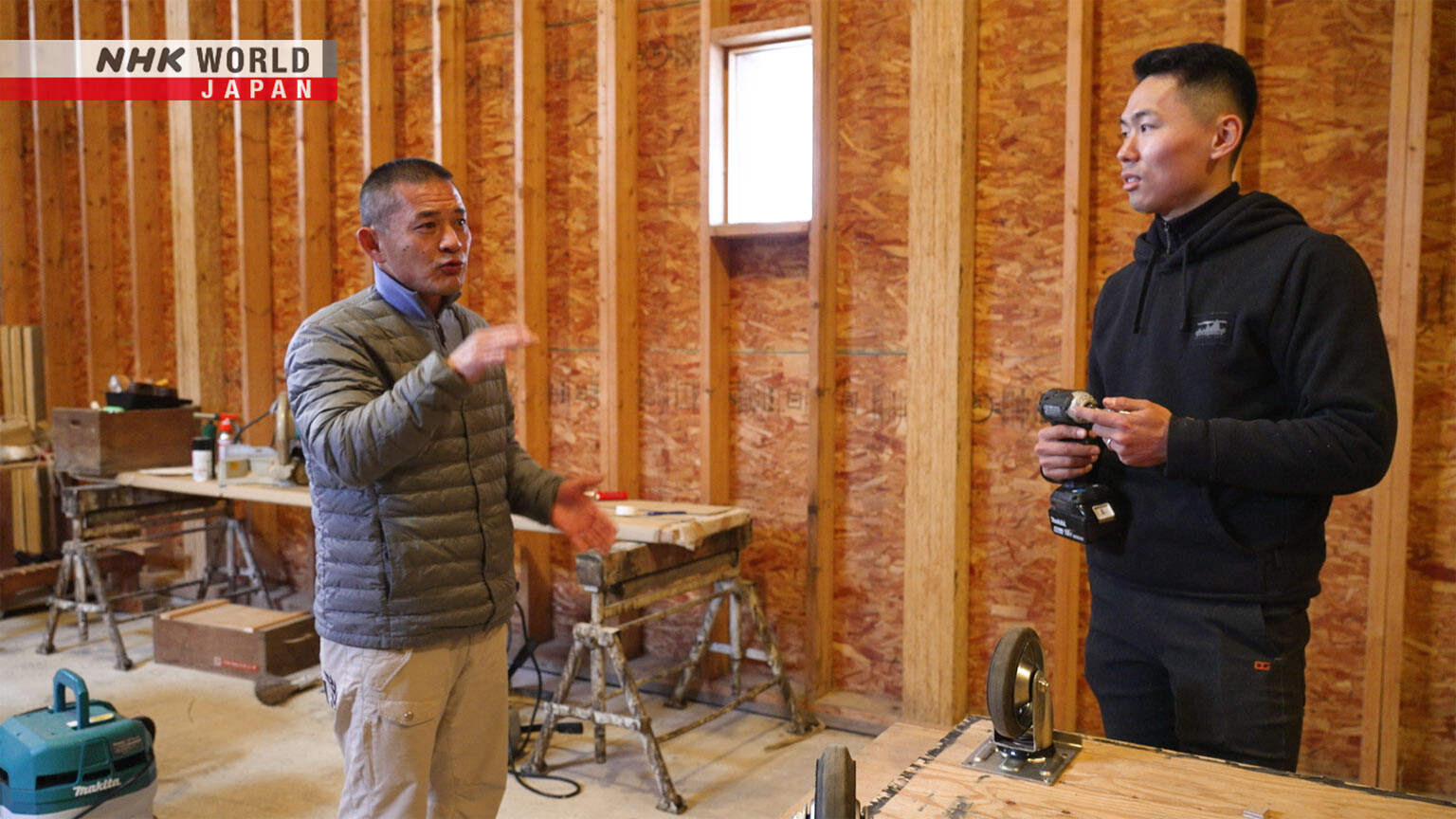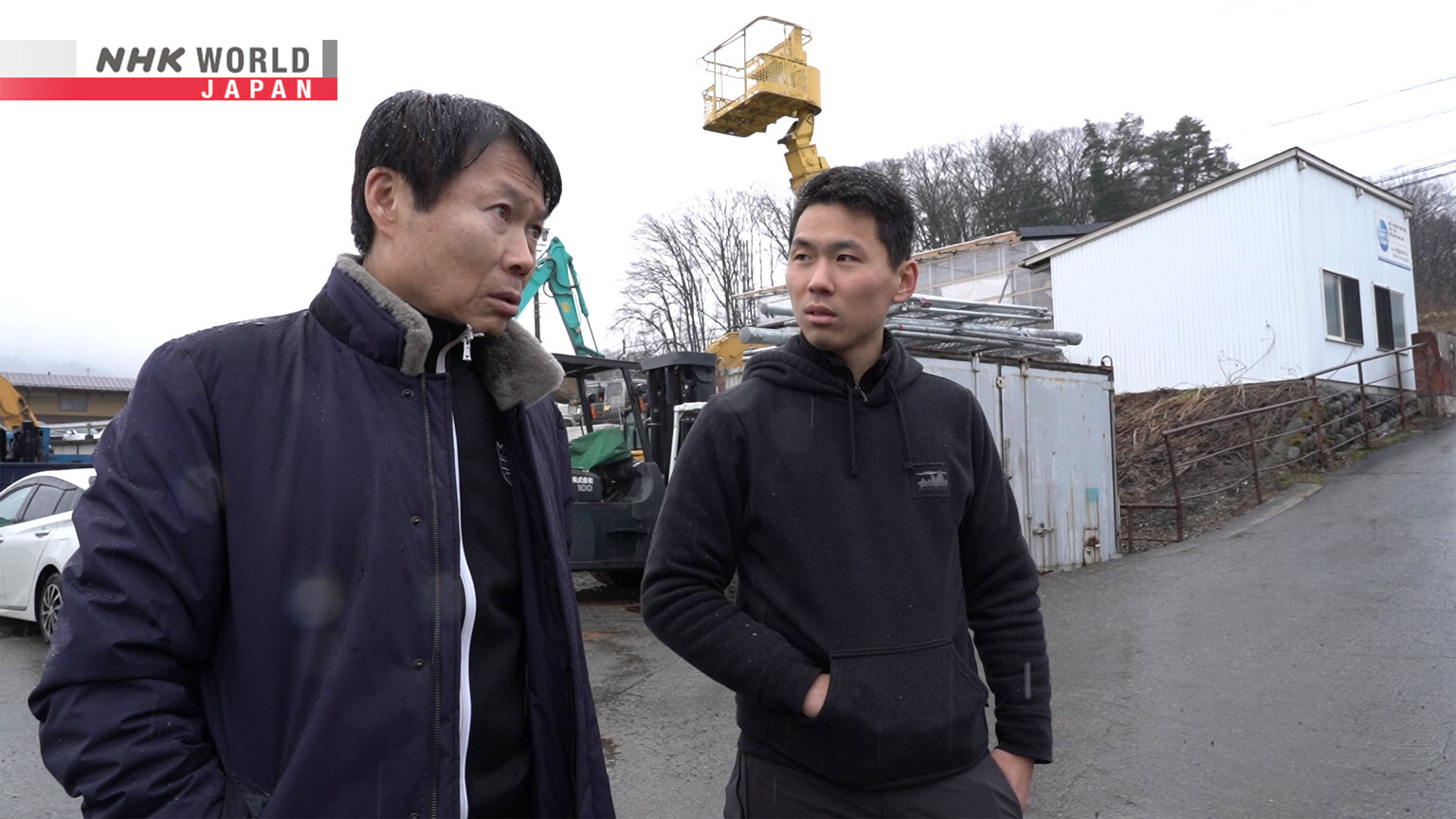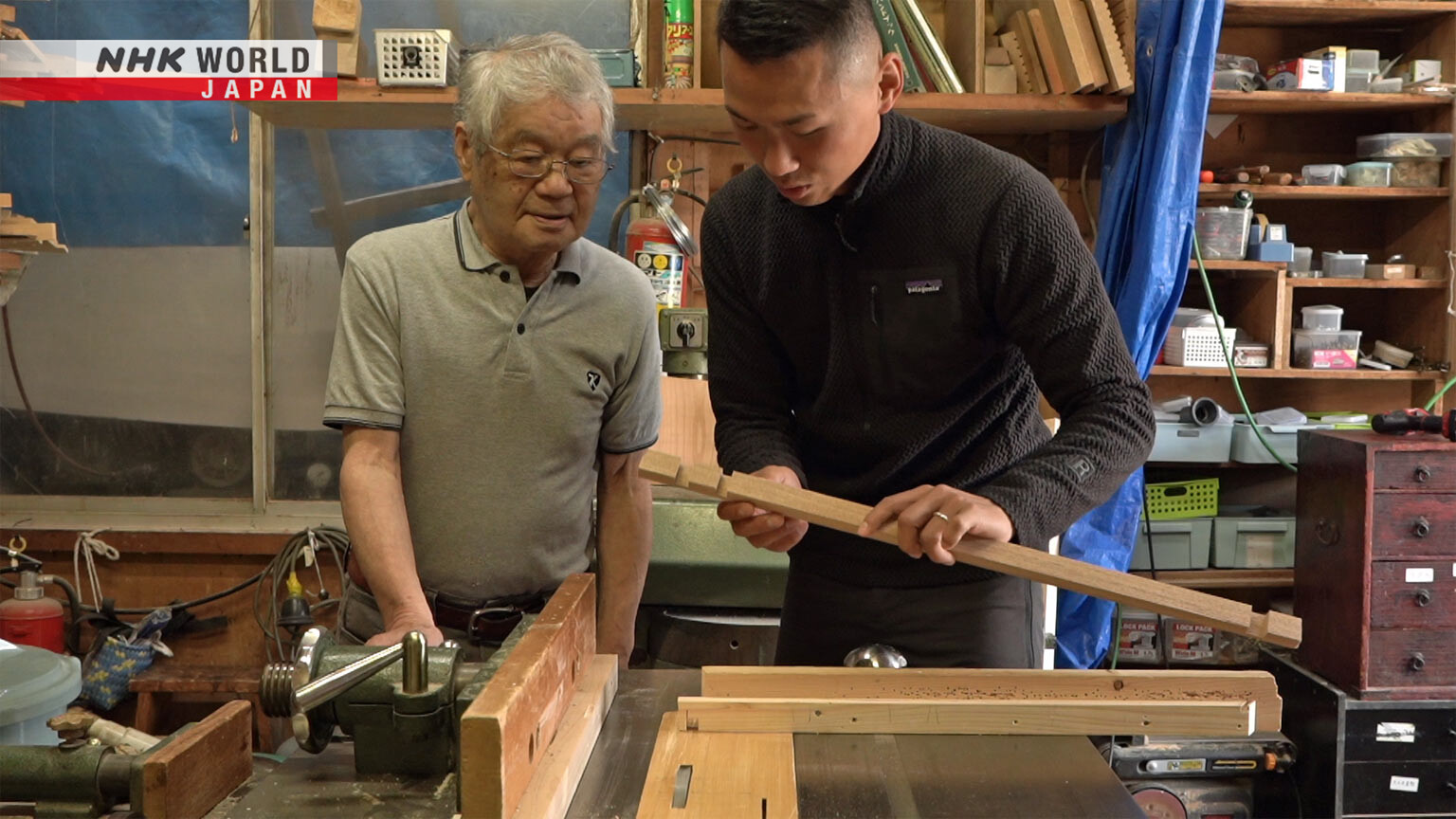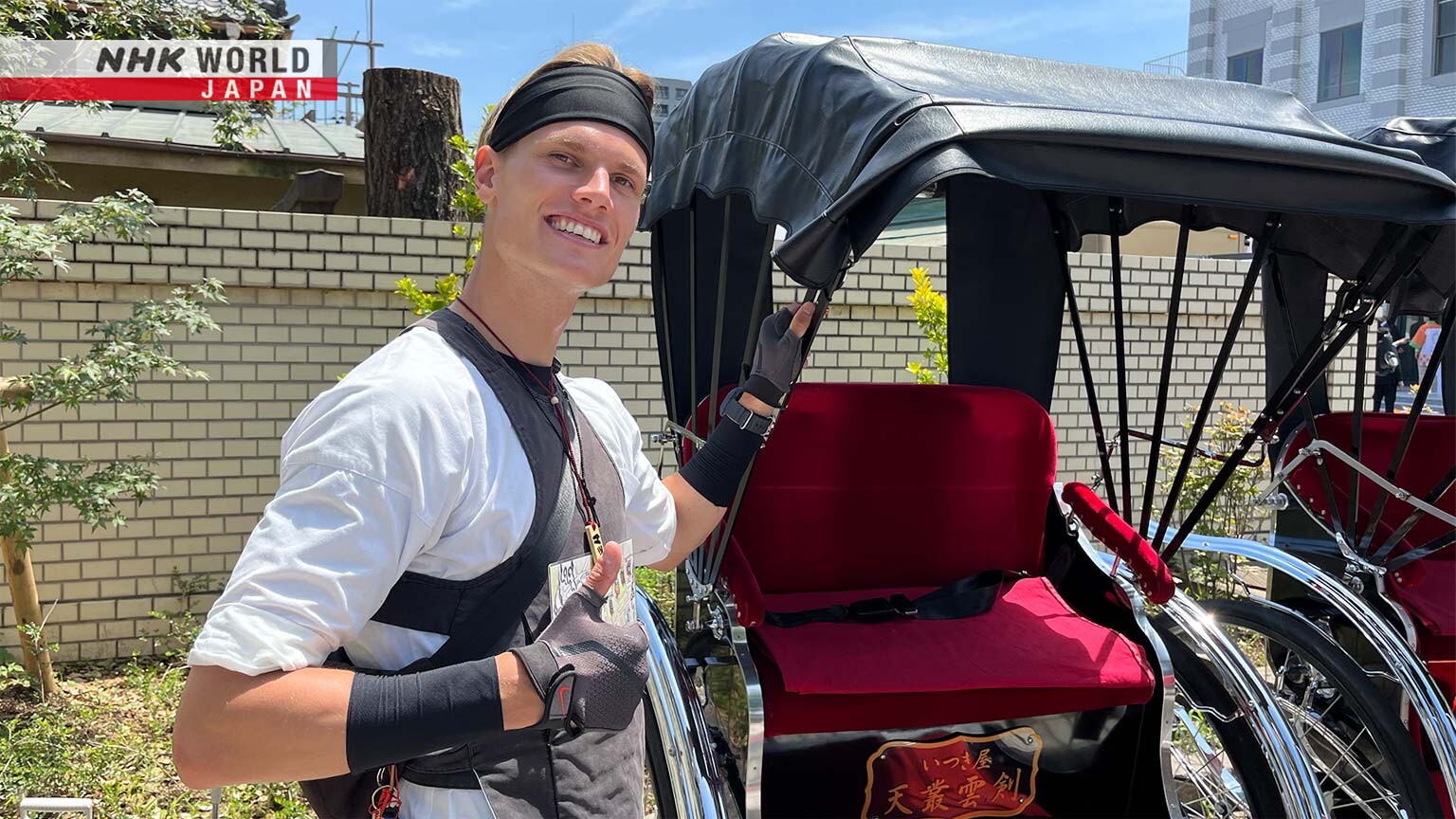Drawn to the Land of Carpentry
We meet South Korean Kang Dong Ju who runs his own carpentry business in Takayama, Gifu Prefecture, and German Max Geiger, a part-time rickshaw tour guide in Kawagoe, Saitama Prefecture.




Transcript
Where We Call Home.
Surrounded by mountains some three thousand meters high - the Hida region.
Blessed with bountiful forests, it's home to master carpenters.
Aspiring to become one such artisan is this young man.
Kang Dong Ju from South Korea.
In this era where most materials for home building are mass produced in factories...
...Dong Ju insists on highly meticulous handwork.
I want to take on the challenge of doing carpentry like no one else does.
He received his very first commission, a fence for a guest house.
- 5mm off.
- That's no good.
But building a fence isn't as easy as it sounds.
Dong Ju journeys along the path to becoming a master craftsman of Hida.
Takayama City in Gifu Prefecture is part of a region called Hida.
Nestled amidst high mountains, its lush forests have fostered time-tested woodworking techniques.
For the quality and precision of their craftsmanship,
local carpenters became known as "Hida Masters."
Kang Dong Ju has been working as a carpenter here for five years.
He just became independent and founded his own business this year.
Today, he visits a house built more than a century ago
which was designated a national important cultural asset.
A complex framework of beams and joists cut with exacting precision and assembled without a single nail.
Looking at the work of masters of old is also part of an aspiring carpenter's training.
It truly shows the craftsmanship.
They really didn't cut corners.
People back then achieved this without using 3D CAD software. It's impressive.
Amazed by this tradition of craftsmanship that makes full use of the wood's properties,
Dong Ju came to settle down in Hida.
Over the one hundred years or so since this residence was built,
the world of carpentry has undergone many changes.
Today, materials for wooden homes in Japan are almost all factory-produced.
The masters of Hida are on the decline.
But Dong Ju decided to become an independent carpenter in spite of these precarious circumstances.
February.
Having just started out in the trade, Dong Ju is having difficulty finding jobs.
He heads out early in the morning.
He arrives at the village of Shirakawa-go, a UNESCO World Heritage Site.
It's famous for its picturesque houses with steep thatched roofs built three hundred years ago.
Dong Ju can also speak English and Spanish.
Until he can earn a living on carpentry alone,
he makes use of his linguistic skills to work as a guide for tourists.
In Japan, we ride at the left side...
Thirty-year-old Dong Ju was born in Busan.
He spent most of his childhood and teenage years overseas.
That's because his father - once an executive for Korea's largest shipping firm -
was often assigned to work abroad.
Dong Ju could have followed in his father's footsteps, but his ambitions were elsewhere.
Business management didn't sound fun.
I thought seriously about what I loved to do as a kid.
I remembered that I had fun doing hands-on work...
like when I repaired things around the house.
He entered university in Korea,
but eventually quit and joined a famous woodworking company in Takayama City.
After training for three years, he became independent, in search of new opportunities.
March.
Dong Ju finally landed his first job.
The company for which he works as a tour guide asked him
to build a fence for a guest house they manage.
The client would like a wooden fence that will fit in with the traditional look of Hida.
Most of the buildings in the town of Furukawa are made of wood.
I want to build a fence that'll blend into the look of the town.
Dong Ju gets to work.
But he just opened his workshop last December.
It's still far from being fully equipped.
He procures the machinery he needs as he goes along.
Hi!
- Did the machine come in?
- Yes.
Dong Ju spent all the money he'd saved to purchase secondhand machinery.
I used it all up.
To get jobs, I can't do business in half measures.
I have to go all the way.
Dong Ju goes all in for his career as a carpenter.
Coming to visit him is someone who's been offering some support -
Sugimoto Tetsuji, the former president of a construction company.
What're you doing?
I need a cart, so I'm making one.
The two met last year through a common acquaintance.
Impressed by Dong Ju's honesty and determination, Tetsuji lent him this workshop for free.
His presence makes things exciting.
I'd retired, so I wasn't doing much.
But meeting Dong Ju inspired me to keep going.
Tetsuji agreed to help Dong Ju with the fence project.
Late March.
Dong Ju arrives at Takayama Station.
Now that he's retired, his father, Chan Young, decided to come see how his son was doing.
It's the first day. I don't know what's happening to me.
To his boy who chose to be a carpenter in a foreign country,
Chan Young wishes to offer a bit of help.
If I can help you out in some way, of course I'm happy to come here.
I'm going to check out a forklift 5 minutes from here. Let's go together.
What must Dong Ju do to ensure his business is successful?
Chan Young looks for an answer.
Over the two weeks he's been staying at his son's workshop,
his feelings have gradually changed.
He realizes Dong Ju has become a part of his community of adoption
and is receiving a lot of support from neighbors, friends and other people around him.
- I brought the rollers.
- Already?
Dong Ju isn't alone here.
I see how the people around him are helping him out...
so that he can get established as a carpenter.
I'm relieved.
It'd been a long time since father and son had spent time together like this.
His mind at ease, Chan Young returned to Korea.
April.
Work on the fence finally begins.
The first step is to prepare the foundations.
They make openings in a thick layer of concrete.
Tetsuji's experience with civil engineering is of great use.
He's overworking me!
Next, Dong Ju heads back to the shop to make the columns.
The lumber he ordered isn't guaranteed to be completely straight.
To make every column the same size with perfectly flat and straight surfaces,
he must shave each of them.
But this proves a challenging task.
The culprit is the hand-fed planer he recently purchased.
Because the lumber he needs to shave is very long,
and the machine hadn't been used for a while,
calibrating it is a lot of work.
He planes the columns several times, yet they're still not flat.
A veteran carpenter who lives nearby comes to his rescue.
- It looks tilted. Am I seeing wrong?
- You're right. It's tilted.
Late in the evening, Tetsuji also comes to help.
Dong Ju insists on millimeter precision.
They continue to repeatedly adjust the machine.
They finish shaving the columns late into the night.
Nothing better to whisk their fatigue away than a homecooked meal prepared by Dong Ju's wife Tomomi.
I'm glad he got his first client.
He came to Japan to learn carpentry. It's great he can make use of his skills.
- Fell in love with him again?
- Speak for yourself.
Nothing to be embarrassed about.
The precisely planed columns are ready to be installed.
Putting them up is a key step in the building of the fence.
They must be perfectly vertical and parallel.
If they aren't completely straight, the horizontal boards that will be installed on them will also be crooked.
The columns are crucial in ensuring a beautiful final look.
Dong Ju uses a laser to project a straight, leveled line,
but putting up the columns along that line must be done by hand.
23.6.
It's quite off.
- 5mm off.
- That's no good.
Two hours have passed.
Tetsuji can't help but comment on Dong Ju's insistence on millimeter precision.
- If the top and bottom match, it's OK.
- I know.
- Hurry and fix them down.
- Just a second.
You and your gadgets.
Yet, he follows Dong Ju's method of working all the way to the end.
It reminds me of when I first started.
The first time I did an on-site job and got a commission from a client.
How was it?
- Same as now.
- Really?
That's what I'm saying.
After long hours of work, the columns are all standing, with no offset in the measurements.
May.
Now, it's time to install the boards that will create the final finish of the fence.
Dong Ju checks the grain pattern on each one
to determine in what order he'll place them.
That one's too bright. Let's use this one.
It won't look good if they're too similar.
He carefully hammers in each nail.
He pays a lot of attention to the placement of the boards
so that the grain creates a beautiful pattern.
Back in his workshop, Dong Ju builds the fence's door.
I won't use nails.
He decided to assemble the frame without nails.
It's painstaking and time-consuming handwork, but Dong Ju,
who aims to become a "Hida master," is particular about using this technique.
He believes that such attention to detail and quality
is what can make the difference in order to keep going as a carpenter.
At last, the fence is complete.
Highlighting the beauty of the wood grain.
The door fits in perfectly.
He carefully chose every element,
from the type of nails to the width of the horizontal and top boards,
creating a simple yet refined design...
...that harmonizes with the look of the neighborhood.
It's very nice. We want to help preserve the sustainability of the Hida region.
So, we want to use natural materials.
I want guests to have a comfortable stay. I can't wait to welcome them.
There are many points I could improve to make it look more beautiful.
But that's what's great about carpentry. We can always make it better.
I'll keep that in mind when I work on the next job.
Dong Ju visits the town of Tenshoji Machi.
Through history, it's been home to many artisans.
Greeting him is Tokorozuki Kiyoshi, a maker of doors and panels for homes.
He's of the few remaining craftspeople who make one of Hida's carpentry traditions.
Chidori trellis is made of wooden pieces interlocked in a complex fashion
so as to hide any joints.
But because it's costly and takes time to produce, it's become very rare.
Mr. Tokorozuki gladly teaches the method to Dong Ju.
If there's the slightest mistake, it won't fit.
Because Mr. Tokorozuki has no successor, he hopes Dong Ju will help preserve the technique.
There are fewer and fewer artisans. It'd be a shame if it disappeared.
So, I hope that by getting others to give Chidori trellis a try...
more people will know about it.
By learning traditional Hida crafting techniques,
Dong Ju looks to the future with big hopes and ambitions.
The region has everything for carpentry.
There are mentors, materials, machinery makers.
Hida is the perfect environment.
If my products are the same as others', they'll only sell for cheap, if at all.
But if I make something original, then the price won't matter.
I have unique skills, like languages.
I can combine them with carpentry to sell products overseas...
and develop new projects.
Hi! I'm Max. I'll be your guide.
I drive a rickshaw in Kawagoe, a city I love. Come with me!
Kawagoe, Saitama Pref.
The town is popular for its look from the Edo era.
8:30 a.m.
arriving at work.
Max works part time for this company that owns a total of seven rickshaws.
The tires feel just about right.
He makes sure the tires are properly inflated.
getting ready to go.
This stops sweat.
With these, the sweat from my arms won't trickle down to my hands.
He wears a different color headband every day.
Time to go clean up.
Before work, he picks up garbage on the streets.
A rickshaw business makes money by using the town itself.
So, we believe it's our duty to help keep the town clean.
Good morning.
Smells nice.
Thank you.
The rickshaw tours famous spots around Kawagoe City.
It helps tourists make precious memories of their visit to the picturesque town.
10:00 a.m.
work starts.
Taking passengers by the hand, Max makes sure they get on safely.
He insists on thoughtful, quality service.
We're ready to go.
My name is Max. Thanks for riding with me.
Shall we go?
Watch out! Rickshaw coming through!
Max came to Japan in 2020, and studied economics in university.
After moving to Kawagoe, he saw rickshaws and wanted to try driving one.
He began working part-time as a rickshaw driver last June.
The technique is to keep my arms bent to dampen the rocking of the rickshaw.
If I lock my arms, it'll rock too much. Loosening my arms makes it rock less.
Max is now famous around Kawagoe.
- Thank you always.
- Smells delicious.
Working hard!
Max helps my business.
He comes to eat, sometimes with friends.
He waves at me when he passes by with passengers. It helps my business.
I'll come again.
You're always welcome.
- This is Tomioka-san, my mentor.
- Nice to meet you.
Max always enlivens the mood.
It shows he really enjoys this work.
He's having fun, and he works hard so customers have fun, too.
- And Kawagoe is fun.
- It sure is.
Our concept is not only to offer tours, but also to build connections...
with the local community.
I hope Max continues to thrive as part of our company.
I'll keep giving it my all. I hope you continue to teach me.
I count on you.
Same here.
Excuse me! Rickshaw coming through!
- We'll always remember this.
- Glad to hear that.
- Take care.
- Thank you.
Thank you!
This is my treasure.
It's got the word "Kawagoe" on the back.
It reminds me of my duty and the joy of promoting the city's appeal.
When I see passengers having fun and being cheerful, it gives me energy, too.
It's like the passengers and I synergize.
We give each other energy. It makes this work so rewarding.
I want to be a full-time employee and promote Kawagoe even more.